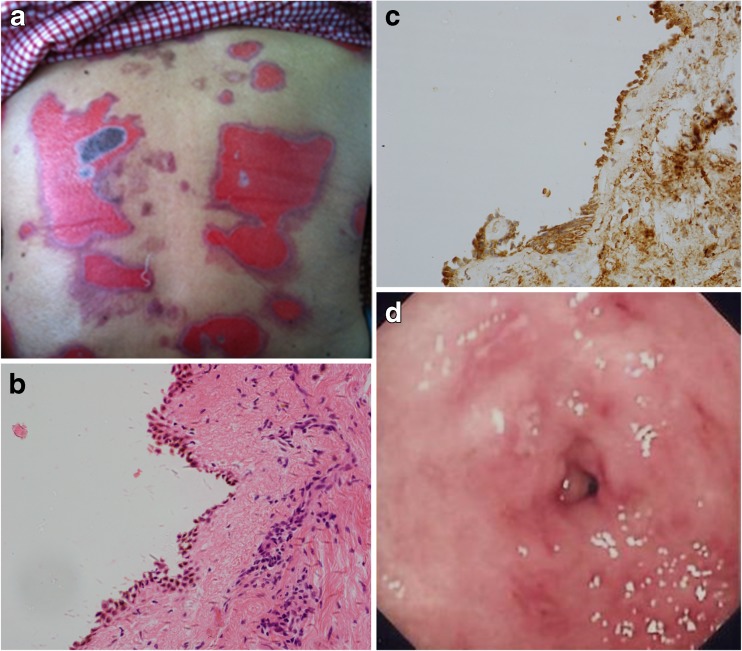Abstract
Paraneoplastic pemphigus is a relatively rare but significant acquired autoimmune mucocutaneous disorder that is characterised by diffuse erythema, painful blistering and sores of the skin and mucus membranes. The underlying pathogenesis is believed to be triggered by altered immune system in response to underlying neoplasm. The manifestations can predate, occur at the same time or after the diagnosis of cancer. Associations with gastric cancer have only been reported twice. A 78-year-old lady presented with a month’s history of extensive skin lesions that started off as bullous lesions and biopsy revealed bullous pemphigus. Endoscopy for anemia revealed gastric cancer. This case reinforced the need to consider underlying malignancy in elderly patient with new onset dermatological presentation.
Keywords: Gastric cancer, Pemphigus vulgaris, Paraneoplastic manifestations, Bullous dermatological lesions
A 78-year-old lady presented with a month’s history of extensive skin lesions that started off as bullous lesions. She had anorexia of recent onset but without any significant weight loss. Physical examination revealed multiple ruptured lesions throughout body (Fig. 1a) (trunk, genitalia and the extremities) with exudative discharge and bleeding. She also had painful lesions around the lip. Laboratory investigations revealed normocytic anemia of 7.3 g/dl. A skin biopsy showed ulcerated skin lesion lined by a layer of discohesive basal cells and direct immunofluorescence study showed pericellular positive staining for IgG consistent with pemphigus vulgaris (Fig. 1b, c). An upper gastrointestinal endoscopy showed diffuse esophageal candidiasis and multiple small geographic ulcers in the antrum (type IIc + a) (Fig. 1d). The biopsies of the antral ulcers showed diffuse infiltrating signet cell adenocarcinoma. Serum anti-desmoglin 3 was positive. A diagnosis of paraneoplastic pemphigus with the gastric cancer was made. A staging computed tomography scan revealed no metastases or any other abnormalities. Despite repeated discussions, the patient declined surgical intervention. She was managed with immunosuppressive therapy with some improvement of the skin condition. Her condition worsened and she passed away almost 2 years after the initial presentation.
Fig. 1.
a Ruptured bullous lesions of pemphigus vulgaris. b Histology showing a layer of discohesive basal cells. c Direct immunofluorescence showing peri-cellular staining for IgG. d Endoscopic image showing multiple small geographic ulcerations in the antrum
Paraneoplastic pemphigus is a relatively rare but significant acquired autoimmune mucocutaneous disorder that is characterised by diffuse erythema, painful blistering and sores of the skin and mucus membranes. The underlying pathogenesis is believed to be triggered by altered immune system in response to underlying neoplasm. The manifestations can predate, occur at the same time or after the diagnosis of cancer. Associations with gastric cancer have only been reported twice [1, 2]. Associations with other malignancies such breast, colon and bladder cancers have been reported [3]. Other paraneoplastic cutaneous manifestations associated with gastric malignancies include Leser-Trelat syndrome, palmo-plantar keratoderma, acanthosis nigricans and paraneoplastic dermatomyositis [4].
Acknowledgments
Conflict of Interest
The authors declare that they have no competing interest.
Financial Declaration
None.
References
- 1.Calzavara PG, Carlino A, Coglio G. Pemphigus and neoplasia. 2 new clinical cases and a review of the literature. G Ital Dermatol Venereol. 1989;124:25–9. [PubMed] [Google Scholar]
- 2.Gül U, Gönül M, Soylu S, Heper AO, Demiriz M. An unusual occurrence of gastric adenocarcinoma in pemphigus vulgaris. Int J Dermatol. 2009;48:1018–20. doi: 10.1111/j.1365-4632.2009.04091.x. [DOI] [PubMed] [Google Scholar]
- 3.Krain LS, Bierman SM. Pemphigus vulgaris and internal malignancy. Cancer. 1974;33:1091–9. doi: 10.1002/1097-0142(197404)33:4<1091::AID-CNCR2820330430>3.0.CO;2-Y. [DOI] [PubMed] [Google Scholar]
- 4.Dourmishev LA, Draganov PV. Paraneoplastic dermatological manifestation of gastrointestinal malignancies. World J Gastroenterol. 2009;15:4372–9. doi: 10.3748/wjg.15.4372. [DOI] [PMC free article] [PubMed] [Google Scholar]



